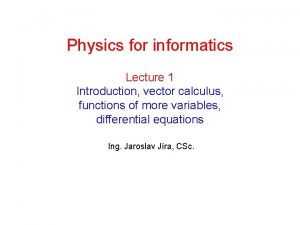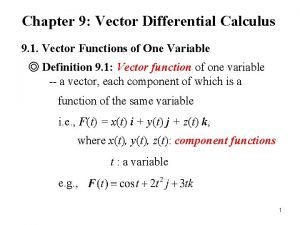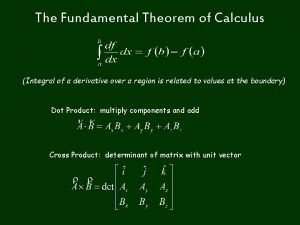16 Vector Calculus Copyright Cengage Learning All rights





















- Slides: 21

16 Vector Calculus Copyright © Cengage Learning. All rights reserved.

16. 4 Green’s Theorem Copyright © Cengage Learning. All rights reserved.

Green's Theorem Green’s Theorem gives the relationship between a line integral around a simple closed curve C and a double integral over the plane region D bounded by C. (See Figure 1. We assume that D consists of all points inside C as well as all points on C. ) Figure 1 3

Green's Theorem In stating Green’s Theorem we use the convention that the positive orientation of a simple closed curve C refers to a single counterclockwise traversal of C. Thus, if C is given by the vector function r(t), a t b, then the region D is always on the left as the point r(t) traverses C. (See Figure 2. ) Figure 2 4

Green's Theorem 5

Example 1 Evaluate C x 4 dx + xy dy, where C is the triangular curve consisting of the line segments from (0, 0) to (1, 0), from (1, 0) to (0, 1), and from (0, 1) to (0, 0). Solution: Although the given line integral could be evaluated as usual by the methods, that would involve setting up three separate integrals along the three sides of the triangle, so let’s use Green’s Theorem instead. Notice that the region D enclosed by C is simple and C has positive orientation (see Figure 4). Figure 4 6

Example 1 – Solution cont’d If we let P(x, y) = x 4 and Q(x, y) = xy, then we have 7

Green's Theorem In Example 1 we found that the double integral was easier to evaluate than the line integral. But sometimes it’s easier to evaluate the line integral, and Green’s Theorem is used in the reverse direction. For instance, if it is known that P(x, y) = Q(x, y) = 0 on the curve C, then Green’s Theorem gives no matter what values P and Q assume in the region D. 8

Green's Theorem Another application of the reverse direction of Green’s Theorem is in computing areas. Since the area of D is D 1 d. A, we wish to choose P and Q so that There are several possibilities: P(x, y) = 0 P(x, y) = –y Q(x, y) = x Q(x, y) = 0 P(x, y) = Q(x, y) = y x 9

Green's Theorem Then Green’s Theorem gives the following formulas for the area of D: 10

Green's Theorem Formula 5 can be used to explain how planimeters work. A planimeter is a mechanical instrument used for measuring the area of a region by tracing its boundary curve. These devices are useful in all the sciences: in biology for measuring the area of leaves or wings, in medicine for measuring the size of cross-sections of organs or tumors, in forestry for estimating the size of forested regions from photographs. 11

Green's Theorem Figure 5 shows the operation of a polar planimeter: The pole is fixed and, as the tracer is moved along the boundary curve of the region, the wheel partly slides and partly rolls perpendicular to the tracer arm. The planimeter measures the distance that the wheel rolls and this is proportional to the area of the enclosed region. A Keuffel and Esser polar planimeter Figure 5 12

Extended Versions of Green’s Theorem 13

Extended Versions of Green’s Theorem Although we have proved Green’s Theorem only for the case where D is simple, we can now extend it to the case where D is a finite union of simple regions. For example, if D is the region shown in Figure 6, then we can write D = D 1 U D 2, where D 1 and D 2 are both simple. Figure 6 14

Extended Versions of Green’s Theorem The boundary of D 1 is C 1 U C 3 and the boundary of D 2 is C 2 U (–C 3) so, applying Green’s Theorem to D 1 and D 2 separately, we get 15

Extended Versions of Green’s Theorem If we add these two equations, the line integrals along C 3 and –C 3 cancel, so we get which is Green’s Theorem for D = D 1 U D 2, since its boundary is C = C 1 U C 2. The same sort of argument allows us to establish Green’s Theorem for any finite union of nonoverlapping simple regions (see Figure 7). Figure 7 16

Example 4 Evaluate , where C is the boundary of the semiannular region D in the upper half-plane between the circles x 2 + y 2 = 1 and x 2 + y 2 = 4. Solution: Notice that although D is not simple, the y-axis divides it into two simple regions (see Figure 8). In polar coordinates we can write D = {(r, ) | 1 r 2, 0 } Figure 8 17

Example 4 – Solution cont’d Therefore Green’s Theorem gives 18

Extended Versions of Green’s Theorem can be extended to apply to regions with holes, that is, regions that are not simply-connected. Observe that the boundary C of the region D in Figure 9 consists of two simple closed curves C 1 and C 2. We assume that these boundary curves are oriented so that the region D is always on the left as the curve C is traversed. Thus the positive direction is counterclockwise for the outer curve C 1 but clockwise for the inner curve C 2. Figure 9 19

Extended Versions of Green’s Theorem Figure 10 If we divide D into two regions D and D by means of the lines shown in Figure 10 and then apply Green’s Theorem to each of D and D , we get 20

Extended Versions of Green’s Theorem Since the line integrals along the common boundary lines are in opposite directions, they cancel and we get which is Green’s Theorem for the region D. 21
 Copyright cengage learning. powered by cognero
Copyright cengage learning. powered by cognero Copyright 2015 all rights reserved
Copyright 2015 all rights reserved Copyright 2015 all rights reserved
Copyright 2015 all rights reserved Dell all rights reserved copyright 2009
Dell all rights reserved copyright 2009 Copyright © 2018 all rights reserved
Copyright © 2018 all rights reserved Vector differentiation
Vector differentiation Vector informatics
Vector informatics Formula for vector
Formula for vector Fundamental theorem of vector calculus
Fundamental theorem of vector calculus 2009 delmar cengage learning
2009 delmar cengage learning Cengage learning heart diagram
Cengage learning heart diagram Cengage learning heart diagram
Cengage learning heart diagram South-western cengage learning
South-western cengage learning Chapter 13 medical math assignment sheet
Chapter 13 medical math assignment sheet 2009 delmar cengage learning
2009 delmar cengage learning Cengage learning heart diagram
Cengage learning heart diagram Introduction to medical terminology chapter 1
Introduction to medical terminology chapter 1 Cengage learning australia
Cengage learning australia Graphing tpr
Graphing tpr Whille
Whille Cengage learning
Cengage learning Wadsworth cengage learning
Wadsworth cengage learning









































